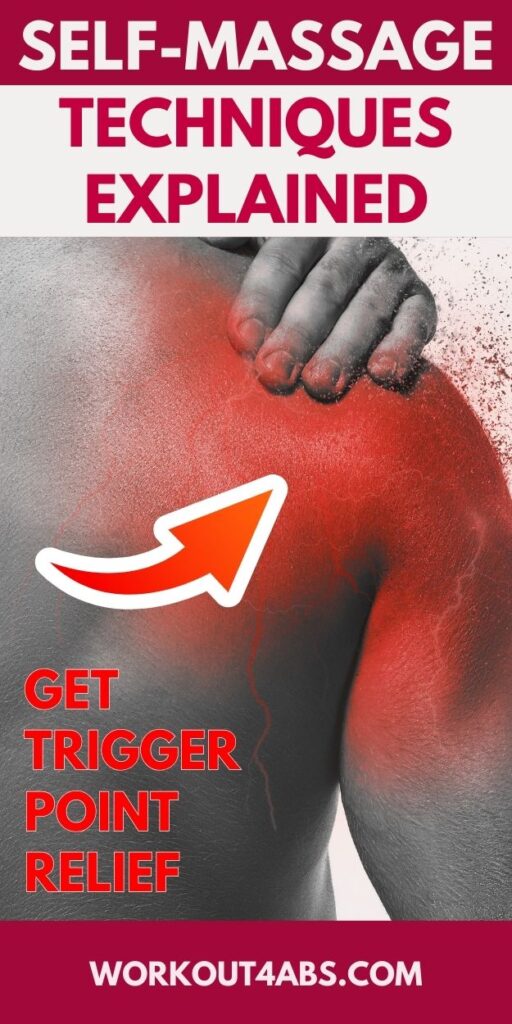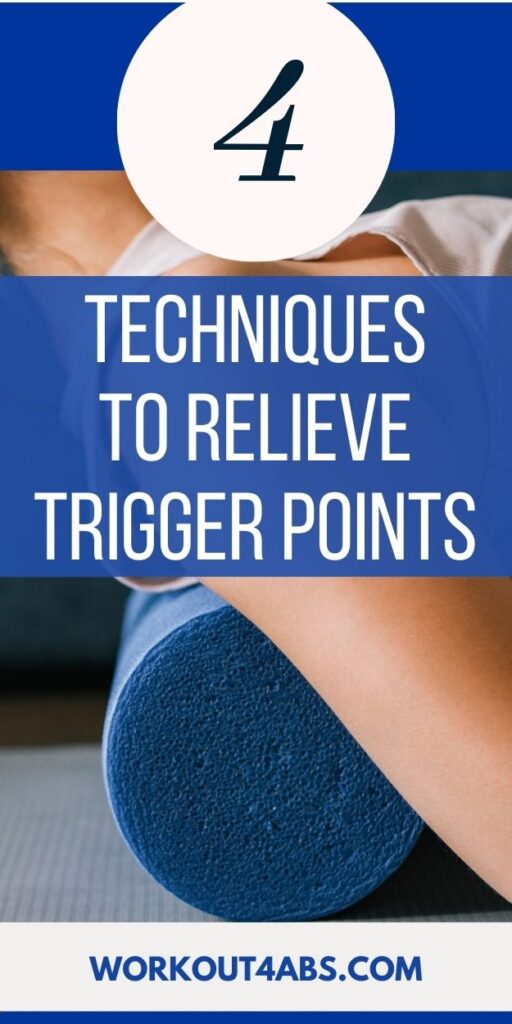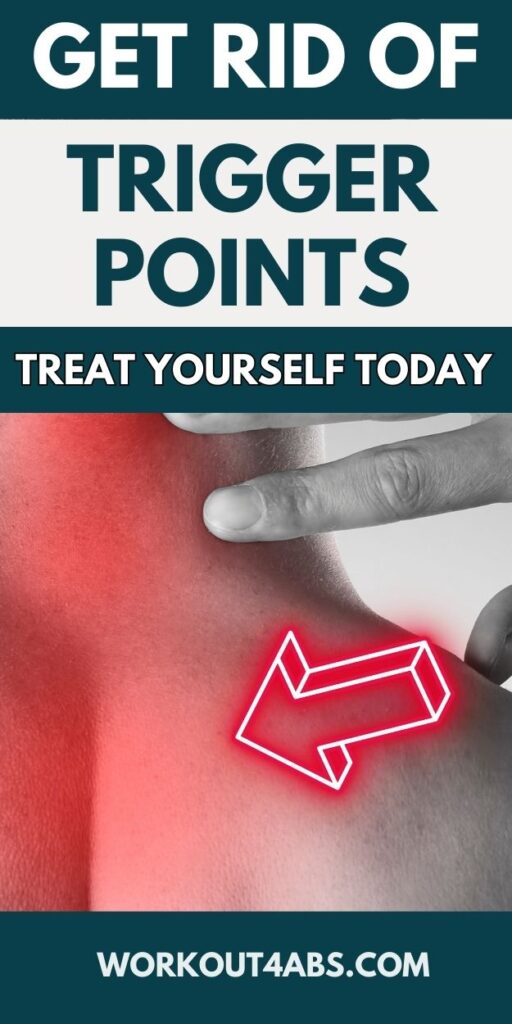Trigger points massage is a powerful technique for alleviating muscle knots and tension. Discover effective methods for locating and massaging trigger points, and learn how targeted stretching and exercises can complement your self-care routine to bring lasting relief and improved muscle health.
The Big Lie about Trigger Points (Knots) & How to Get Rid of Them.
If you enjoyed these tips, please save this pin to your Pinterest Board.

How to Find a Movement to Make the Trigger Point Better
The concept that if you can create a movement that makes a trigger point worse, you can also create a movement that makes it better is rooted in the principles of myofascial pain and muscle physiology. Trigger points are localized areas of muscle fibers that are in a constant state of contraction, causing pain and discomfort. Here’s why movement can play a role in both exacerbating and alleviating trigger points:
- Muscle Contraction and Blood Flow: When you engage in certain movements or postures, you can inadvertently increase muscle tension and compression on trigger points. This can restrict blood flow to the affected area, reducing oxygen and nutrient supply to the muscles. Insufficient blood flow can exacerbate trigger point activity, leading to increased pain and discomfort.
- Muscle Stretching and Relaxation: Conversely, specific movements and stretches can target and release trigger points. Gentle stretching and movements encourage muscle fibers to elongate and relax. This increased length can disrupt the constant contraction in the trigger point and promote better blood flow, allowing the muscle to return to a more relaxed state.
- Breakdown of Trigger Points: Some movements and techniques, such as self-massage or foam rolling, can apply direct pressure to trigger points. This pressure can help release the tight muscle fibers and promote the breakdown of adhesions within the muscle. This process is known as myofascial release and can lead to pain relief and improved muscle function.
- Neuromuscular Re-education: Certain movements and exercises can re-educate the nervous system and promote better muscle function. This can involve activating and strengthening specific muscles to support proper posture and movement patterns, reducing the likelihood of trigger point formation.
- Individual Variability: It’s important to note that individuals may respond differently to various movements and techniques. What exacerbates trigger points in one person may alleviate them in another. This is due to differences in muscle imbalances, posture, and the specific nature of the trigger points.
In summary, the relationship between movement and trigger points is dynamic. Movement and specific techniques can either worsen or improve trigger point symptoms based on factors like muscle tension, blood flow, and the individual’s unique physiology. Understanding how to apply appropriate movements and techniques can be a valuable tool in managing trigger point-related discomfort and promoting muscle health.
If you enjoyed these tips, please save this pin to your Pinterest Board.

Forward Head Posture Creates Trigger Points
Forward head posture is a common issue characterized by an excessive forward curvature of the neck and a protruding head position relative to the shoulders. This posture can contribute to the development of trigger points, primarily in the upper back, neck, and shoulder muscles, for several reasons:
- Muscle Imbalance: In forward head posture, the muscles at the front of the neck (anterior neck muscles) tend to become chronically shortened and tight, while the muscles at the back of the neck and upper back (posterior neck and upper back muscles) often become overstretched and weakened. This imbalance in muscle activity can lead to trigger points forming in the overused and tight muscles.
- Overuse of Muscles: The muscles responsible for maintaining an upright head posture are continually working to counteract the forward pull of the head. This constant effort can lead to muscle fatigue and the development of trigger points in the neck and upper back muscles.
- Increased Muscle Tension: Forward head posture can cause increased tension and compression on the cervical spine (neck vertebrae). This can result in muscle spasms and trigger point formation as the muscles attempt to stabilize the neck and support the head’s weight.
- Reduced Blood Flow: The forward position of the head can compress blood vessels and impede blood flow to the muscles in the neck and upper back. Inadequate blood supply can contribute to the development of trigger points, as muscles may not receive the necessary oxygen and nutrients to function optimally.
- Altered Biomechanics: Forward head posture alters the biomechanics of the upper body, affecting how muscles work together. This can lead to abnormal muscle recruitment patterns and muscle imbalances, increasing the likelihood of trigger point development.
- Prolonged Stress: Forward head posture is often associated with increased stress on the neck and shoulder muscles due to the constant strain of holding the head in a forward position. Chronic stress can trigger muscle tension and the formation of trigger points.
To prevent or alleviate trigger points caused by forward head posture, it’s important to address the underlying postural issue. This may involve:
- Ergonomic adjustments: Ensure your workspace, computer monitor, and seating are ergonomically designed to encourage proper posture.
- Postural exercises: Engage in exercises and stretches that strengthen the neck and upper back muscles while promoting a more neutral head and neck position.
- Body awareness: Pay attention to your posture throughout the day and make a conscious effort to maintain a more upright head position.
- Self-massage and stretching: Use techniques like foam rolling, stretching, and self-massage to relieve muscle tension and address trigger points in the affected areas.
- Consultation with a healthcare professional: If forward head posture and trigger points are causing persistent pain or discomfort, consider seeking advice from a physical therapist, chiropractor, or other healthcare professional who can provide personalized guidance and treatment.
Trigger Point Therapy
Massage of trigger points, also known as trigger point therapy or myofascial release, is a technique used to alleviate muscle knots and areas of tightness, known as trigger points, in the muscles. Here’s how to perform trigger point massage:
Materials Needed:
- Your hands or fingers.
- A lubricant such as massage oil or lotion (optional).
Procedure:
- Preparation:
- Find a quiet and comfortable place to sit or lie down. Ensure that you are relaxed, and the muscles you plan to work on are accessible.
- Locate the Trigger Point:
- Use your fingers or the pads of your thumbs to locate the specific area where you feel the knot or tension. Trigger points often feel like small, tender, or sore spots within the muscle.
- Apply Pressure:
- Begin by applying gentle pressure to the trigger point. Start with light pressure and gradually increase it as needed, but avoid causing excessive pain. The goal is to feel a comfortable amount of pressure without straining.
- Hold and Breathe:
- Once you’ve applied pressure, hold it steady and take slow, deep breaths. Relax your muscles and focus on the sensation of the pressure on the trigger point.
- Assess Sensation:
- Pay attention to how your body responds. You may feel sensations like warmth, tingling, or a “release” of tension in the muscle. Some discomfort is normal, but the pressure should not be excessively painful.
- Use Various Techniques:
- While maintaining pressure on the trigger point, you can experiment with different techniques:
- Static Pressure: Steady pressure on the trigger point for 20-30 seconds or longer.
- Circular Motion: Gentle circular movements over the trigger point.
- Pin and Stretch: Apply pressure and then gently stretch the muscle by moving the associated joint.
- While maintaining pressure on the trigger point, you can experiment with different techniques:
- Release and Rest:
- After holding the pressure for an appropriate duration (typically 20-30 seconds), release the pressure slowly. Allow the muscle to rest for a moment before repeating the process if necessary.
- Repetition:
- You may need to repeat the process multiple times on the same trigger point or move to different areas to address other knots.
- Stretching:
- After working on the trigger point, it’s beneficial to perform gentle stretches for the muscle to encourage relaxation and lengthening.
Tips:
- Communicate with your body: Listen to your body’s response. If the pressure becomes too painful or if you experience numbness or tingling, release the pressure immediately.
- Gradual pressure: Start with light pressure and increase it gradually as tolerated. Avoid causing undue pain or injury.
- Be patient: Trigger point therapy may take time, and it’s common to require multiple sessions to fully release stubborn knots.
- Seek professional help: If you have persistent pain or are unsure about performing trigger point massage, consider consulting a licensed massage therapist, physical therapist, or healthcare professional for guidance and treatment.
Trigger point massage can be an effective way to release muscle knots and alleviate tension, but it’s essential to perform it carefully and with mindfulness to ensure safety and effectiveness.
If you enjoyed these tips, please save this pin to your Pinterest Board.

Home › Posture Exercises ›Trigger Point Massage